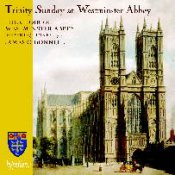Trinity Sunday, the Sunday after Pentecost, is an unusual day in the Anglican church calendar—the only feast devoted to a doctrine—and the present recording presents music that one “might hear if you visited Westminster Abbey on Trinity Sunday.” The range of composers and styles represented is wide: Thomas Tomkins and John Farmer from the “Golden Age,” the richly Victorian John Stainer and George Elvey, twentieth-century stalwarts like Edward Bairstow, Herbert Howells, Benjamin Britten, and William Walton, and even a “modern” Francis Grier, all arranged to give a musical sense of the three choral services of the day: Matins, Eucharist, and Evensong.
The range seems to reflect actual practice, with the Dean of Westminster in a program note even suggesting that the range is, in context, “Trinitarian.” He writes that “from Tomkins through Elvey to Britten and Walton is comprehensive, mixing different styles, while their distinctiveness remains. Does not that exemplify the Trinity? One liturgy but three distinct but non-competing styles?” So, the recording is tightly thematic, although that said, the recording also seems perhaps a bit at odds with itself. In some ways it attempts to give a sense of being at a service—the opening peal of the Westminster bells, for instance, or the “functional” Preces and Responses at Matins are what one might expect in a service recording. But by the same token, the Evensong section omits responses and prayers, providing only the more musically substantial items. Surprisingly—and regrettably—none of the liturgical sections include any hymnody.
Other aspects of the programming are curious. The cathedral repertory is one rooted in tradition, and thus the frequency with which certain works get recorded is not altogether surprising. However, two of the larger works on the recording, Grier’s Missa Trinitatis Sanctae and Howells’ Magnificat and Nunc dimittis from the Westminster Service have both been recorded by the Abbey Choir under O’Donnell’s predecessor, Martin Neary, as recently as the mid-1990’s. This seems too much repetition, too soon. And, if the recording is to include but only one anthem, one wonders if Stainer’s “I saw the Lord” is the best choice. Its Victorian vocabulary easily seems decidedly melodramatic today in a way that is difficult to overcome, though admittedly, “after the smoke clears,” his lyric section is a welcome reminder of the tunefulness of the age.
Certainly there is much to like in the performances. I thought the choir at its best in the “Gloria” from Grier’s evocative Mass, where the combination of brilliant treble sound and marked rhythmic verve were particularly memorable. And, in general, it was the exuberant moments in a number of pieces—the climax of the Britten Te Deum, for instance—that found the choir most satisfyingly at home.
Certain other aspects were less satisfying. The evensong psalm, Psalm 107, is one of the longer, with a demanding forty-three verses. Given its great length, one might have imagined a more varied approach to the chanting, though the organist’s rumblings to depict “they . . . stagger like a drunken man” were well aimed. Also, in some instances throughout the recording, the blend seemed to suffer from too much vibrato in the lower men’s range. This proved particularly distracting in the mystical, intertwining lines of the Grier “Sanctus.”
“Trinity Sunday at Westminster Abbey,” though not without some curiosities and minor flaws, remains a welcome document of the richness of a liturgical and musical treasure. The distinguished musical tradition of the Abbey is, as always, one to savor.
Steven Plank
Oberlin College
